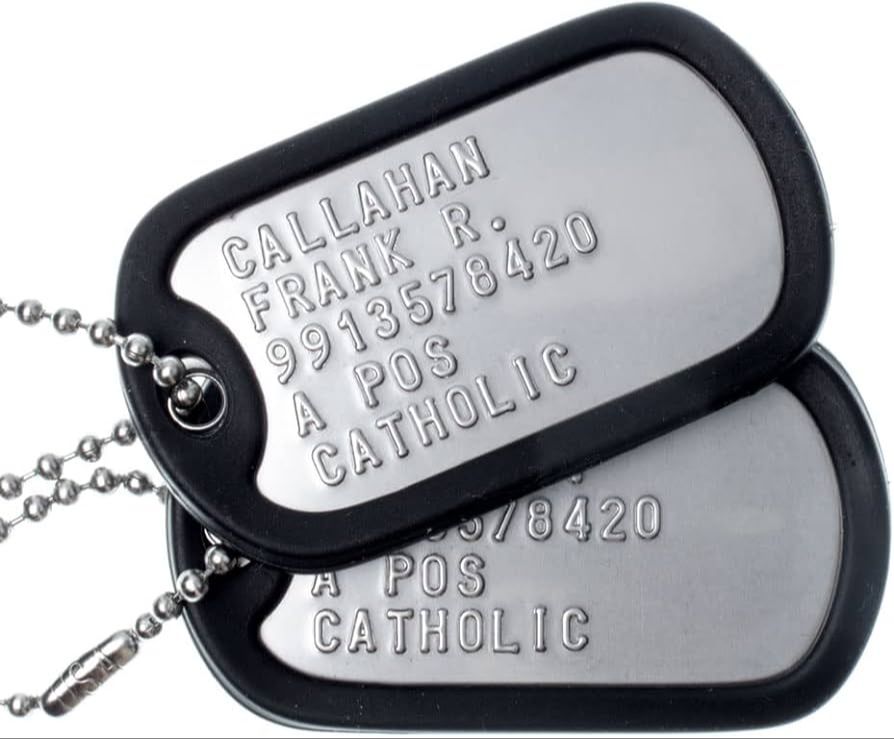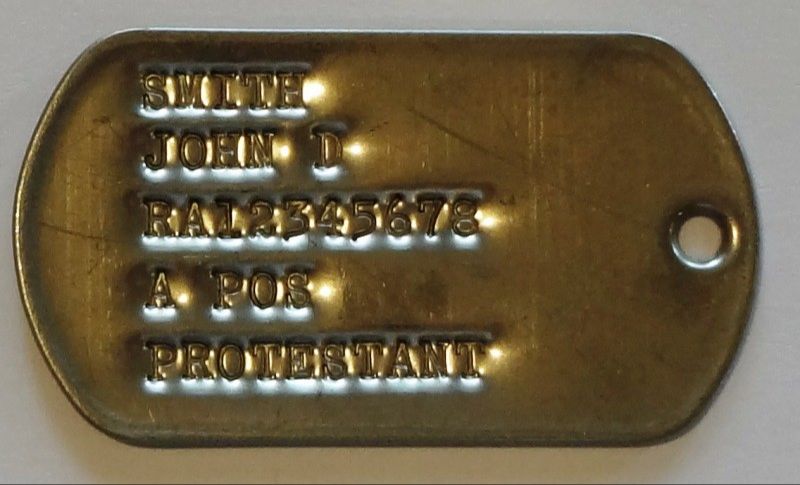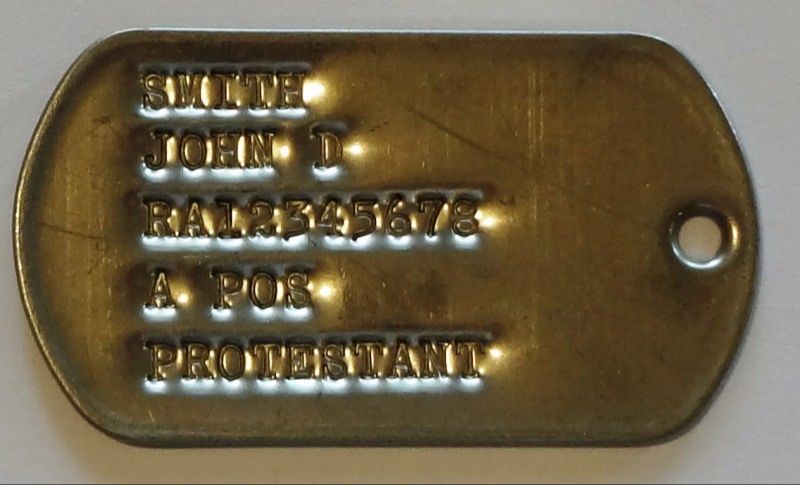Introduction
Dog tags, also known as military identification tags, have a long history dating back to the Civil War era in the 1860s. Though the earliest tags were not standardized, soldiers began wearing identification tags or discs with their names and addresses stamped on them so their bodies could be identified if they were killed in battle. This practice became widespread during World War I, when identification tags were issued to all military personnel.
The purpose of military dog tags is straightforward – they are there to identify the wearer. Standardized dog tags list the service member’s name, Social Security number, blood type, and religious affiliation. This helps ensure a proper burial if the service member is killed in action. Dog tags allow quick identification of the fallen on the battlefield or in the event of a disastrous fire or explosion that renders a body unidentifiable.
Format
Standard military dog tags are approximately 2 inches long by 1 1/8 inches wide and are shaped like a rectangle with rounded corners. Most dog tags are made from stainless steel or another durable, corrosion-resistant metal (Source). The thickness of the dog tag can vary, with 0.5mm to 2mm being common. Military dog tags have a hole punched at the top so they can be worn around the neck on a metal chain or ball chain.
The tags are stamped or engraved with information unique to the service member. The text is raised or indented so it can be identified by touch if necessary. The edges are rolled for comfort and safety. While the overall format of standard U.S. military dog tags has remained largely consistent over the decades, the information contained on them has evolved.
Information Contained
Dog tags contain several key pieces of information about the service member wearing them. This includes the soldier’s name, rank, and service number. The name is written in a standard format with the last name first, followed by a comma, first name and middle initial. The rank indicates the service member’s pay grade and position. The service number is an identifying number unique to that individual.

Dog tags also list the soldier’s blood type. This is crucial medical information in case a transfusion is needed during combat. The tags clearly display the service member’s blood type (A, B, AB, or O) as well as their Rh factor (positive or negative).
Another important element is the soldier’s religious affiliation. The options for this include a wide range of major religions such as Christianity, Judaism, Islam, Buddhism, and Hinduism. This designation assists chaplains in providing appropriate religious services and allows for quick identification if burial preparation is required. Having this information immediately on hand helps ensure service members receive proper religious care.
Overall, dog tags contain vital personal data for identification and medical treatment. The standardized format allows quick access to name, rank, service number, blood type, and religious affiliation. This helps ensure service members can be accurately identified and cared for if needed in combat situations.
Branch Markings
Military dog tags are marked with an abbreviation that identifies the service branch. Here are the key details to identify each branch:
Army dog tags will have the letters “US ARMY” engraved on the bottom of the tag. Army tags may also include a symbol with the letters “A Co” which stands for “Army Company.”
Navy and Marine Corps dog tags are engraved with “US NAVY” or “USMC” for United States Marine Corps. Navy tags will sometimes have an anchor symbol while Marine tags may display the Marine Corps emblem of the eagle, globe, and anchor.

Air Force dog tags are marked with “US AIR FORCE.” They can also have an inscription of “USAF” or a symbol of the Air Force coat of arms with wings and stars.
Knowing the branch abbreviations and symbols allows quick identification of which service a military member belonged to. With practice, the differences between Army, Navy/Marines, and Air Force tags can be discerned at a glance.
Decode Name
Dog tags list the service member’s name in a specific format designed for quick identification. The last name is listed first, followed by a comma, and then the first and middle initials. For example, John A. Doe’s dog tags would read:
DOE, J.A.
Listing the last name first makes it easy to alphabetize records and identify personnel. The first and middle initials help distinguish those who share the same last name.
Some branches, such as the Marine Corps, may list the full first name rather than just an initial. However, the last name is always first when decoding a military dog tag.
Service Number
The service number is a unique number assigned to each service member. According to MOORE MILITARIA, the Army service number was 8 digits and had one of the following prefixes:

- RA (Regular Army, volunteer enlisted)
- US (an enlisted draftee)
- NG (National Guard)
The first one to five digits identify the service member, while the last two digits indicate the year the soldier turned 18 years old. For example, a dog tag with the number 111111/00/00B would mean the soldier’s ID is 11111 and they turned 18 in 2000.
The service number provides a unique identification for each military member that remains with them throughout their service.
Blood Type
The most common blood types are A, B, AB, and O. Blood type is included on dog tags because it provides crucial medical information to medics in the event a soldier is injured on the battlefield. Knowing a wounded soldier’s blood type allows medics to perform life-saving transfusions if needed. According to the U.S. Army, blood type has been included on dog tags for over 70 years as a way to quickly identify a soldier’s blood type in emergency situations.
As explained on ArmyDogTags.com, “That is why blood type has been designated on Dog Tags for over 70 years. … If you select: “Exact number of spaces” this means if you put 5 blank spaces in the blood type field on your Army Dog Tags it will print your tags with exactly 5 blank spaces in the blood type field.” Identifying blood type can literally save a soldier’s life if they need an urgent blood transfusion.
Religious Affiliation
A service member’s religious affiliation may optionally be included on military dog tags. The most common religious affiliations marked are Christian denominations like CATH for Catholic, PROT for Protestant, J for Jewish, and M for Muslim. Others include BUD for Buddhist and ATH for Atheist.

Listing one’s religious affiliation serves an important purpose – it helps guide medical treatment in emergency situations. Knowing a soldier’s faith can help doctors make important care decisions, especially regarding blood transfusions and end of life care. For example, a doctor would know not to administer blood products to a wounded Jehovah’s Witness based on their NOBLD dog tag marking.
Sources:
[What religions can you put on dog tags?](https://www.quora.com/What-religions-can-you-put-on-dog-tags)
Other Markings
Dog tags may also contain additional identifying information besides the standard name, service number and blood type. For example, soldiers can indicate any special medical conditions or allergies they may have.
According to the Tactical Gear article, dog tags can specify medical alerts like penicillin or bee sting allergies. This ensures medics are aware of any critical treatment information when a soldier is injured.
Dog tags are also marked in accordance with the Geneva Conventions for proper identification of wounded or deceased military personnel. This includes engraving a ‘G’ if the wearer is Geneva Conventions protected personnel. Captured personnel may also have a Geneva Conventions category added as a suffix to their service number on dog tags.
Conclusion
In summary, military dog tags are an important identification system in the armed services. They contain key information about the service member including their name, service number, blood type, and religious affiliation. The tags allow quick identification of a soldier, even if they are injured or killed in action. Though technology has progressed, dog tags endure as a simple, lightweight, and effective way to provide critical information about each service member.
While dog tags today serve more as a secondary identification system, they still hold great significance. For many soldiers, receiving dog tags represents their official entry into the military. The tags stay with them throughout their service as a constant reminder of their commitment and sacrifice. Soldiers commonly wear them not just for function, but also for the deep tradition and honor they represent. The dog tags’ design allows them to survive even the most brutal conditions, just as the stoic service members who don them.
